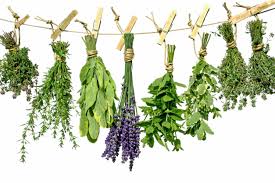 Herbs and spices are such an important part of food and nutrition. As well as providing taste and colour to food many have numerous nutritional benefits as they are full of phytonutrients. Phytonutrients (sometimes referred to as 'phytochemicals') are compounds in all plants which protect it and help it grow. These are the things that alongside vitamins and minerals offer us health benefits. You may have heard of some specific phytochemicals such as tannins, caffeine, phytates and reservatrol. Some of the best known culinary herbs with superb health benefits include basil, rosemary, thyme, sage, cinnamon, cardamon, liquorice, chamomile, oregano, ginger and fennel. Probably the easiest and safest way to consume most culinary herbs is through a infusion (or a tea). This requires you to pour boiling water over dry or fresh herbs (normally 1 heaped teaspoon, or 1 teabag) and leave to steep for 10 – 15 minutes (preferably with a lid or a cover to avoid the loss of volatile oils). Drink three times daily for health benefits. Here are some healthy herbals teas and why they can benefit you: Chamomile: calming and anti-inflammatory. Great for digestive issues especially when caused by stress or anxiety Cinnamon: Very soothing for diarrhoea. Warming for those with poor circulation Fennel: for gas bloating and IBS. Also good for breastfeeding mothers as it increases breast milk production. Liquorice: anti-inflammatory and soothing for the stomach, good for constipation as a mild laxative. Not recommended for those with high blood pressure Nettle: very good for seasonal allergies Peppermint: for gas, bloating and IBS Sage: for menopause (hot flushes), and soothing to sore throats Spearmint: may be useful for conditions with high androgens such as PCOS and acne (**N.B. some herbs even taken as a tea, should be used with caution or on advice if pregnant or on medication) But adding herbs to food is just as easy and can really boost flavour of so many dishes. Here are three of my favourite culinary spices. Curries from Asia famously contain many herbs and spices and one of the most interesting and heavily researched is turmeric which is becoming more and more used in therapeutic doses for its natural anti-inflammatory actions so excellent for joint pain or inflammatory conditions. I also love adding fresh or fried turmeric to scrambled eggs (always with black pepper which helps with the absorption) or to a cup of bedtime golden milk (see recipes). Cardamom is another lovely spice known for its anti-carcinogenic properties, as a digestive aid and in relation to helping urinary infections. Its also high in manganese and iron. Again this is quite often used in South East Asian and Scandinavian cooking. But cardamom has a natural affinity with sweet so I quite often grate a little into cakes or puddings, especially anything chocolate. Fantastic in hot chocolate (see recipes). Lastly, ginger. Beautiful, powerful, unforgettable ginger is wonderful as it can be used in curries to add heat (many Indian and Thai curries use ginger as standard), in sweet dishes or cakes and in reality is gorgeous just on its own in some boiling water. Ginger contains a compound called gingerol which is what gives it its anti-inflammatory properties and also its anti-nausea merits. Ginger and lemon in hot water first thing in the morning throughout winter. Can't beat it.
0 Comments
Leave a Reply. |
AuthorLouise Cullen Archives
October 2020
Categories
All
|
 RSS Feed
RSS Feed
